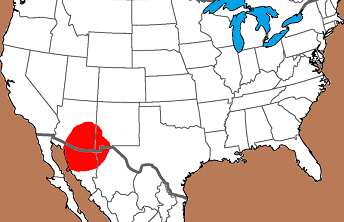Name Details:
Named By: E. B. Sayles (described) / Gregory Perino (named)
Named For: Sacaton (near type site), Pinal County, Arizona
Date Identified: 1965 / 1991
Type Site: Snaketown Site, Pinal County, Arizona
Sacaton
(Collector Type)
Cluster:
Commonly Utilized Material:
Date:
Cultural Period:
1,100 - 900 B.P.
Late Prehistoric / Developmental
Vandal Minimum to Medieval
Warm
Hohokam Culture
Glacial Period:
Culture:
Outline is Representative of Size and Shape:
Description of Physical Characteristics and Flaking Pattern:
This is a thin small (1 to 1.25 inches) triangular side notch point with a flattened cross section. The blade is primarily straight, but may vary from slightly excurvate to slightly incurvate.
Wide parallel notches enter low on the blade forming a horizontal shoulders and an expanding stem. The stem is the widest portion of the blade. The base is slightly concave. This point has a
random flaking pattern.
Size Measurements: Total Length - 11 to 19 mm,
Stem Length - 4 to 6 mm, Blade Width - 7 to 12 mm, Neck
Width - 5 to 7 mm, Basal Width - 8 to 12 mm
Distribution:
Distribution Comments:
This point is primarily found in central Arizona and into southwestern New Mexico within the Hohokam cultural region.
Extends into Sonora and Chihuahua Mexico.

Additional Comments:
This type was discussed by Saylers in his publication on the Snaketown site in Arizona. This type was found in association with other Snaketown types, but lack the deep symmetrical
serrations that mark other Snaketown types
.
Loyd Doty reports:
SACATON or SACATOON (Side Notch True Arrowhead) – is from the Spanish word zacate meaning ‘coarse grass’. Sacaton was a village of the Maricopa
Indian people before the Gila River Indian Reservation was established in 1859. This point type was initially described by E. B. Sayles and much later named by Greg Perino
for examples recovered from the Snaketown archaeology site near Sacaton, Pinal County, Arizona. They are small (1” to 1 ¼”) projectiles with notches close to the bases. The bases are concave and the widest part of the. Blade edges expand and shoulders are moderately strong with sharp to round barbless corners. Distribution includes Arizona, New Mexico, north central Old Mexico and they were used during the Desert Traditions Developmental Phase. Reference: Gladwin, Harold
S., Winifred Gladwin, Emil Haury, & Edwin Sayles 1938, “Excavations at Snaketown: Material Culture.” Medallion Papers. Gila Pueblo, Globe, Arizona; pp. 1–11.
Pictures:
Other points in this Cluster:
Point Validity: Collector Type
Sayles was a pioneering avocational “field” archaeologist who conducted one of the first archaeological surveys of Texas. He was the co-founder of the Texas Archaeological
Society. Perino was a well-respected self-taught archeologist who was the founder of the Illinois State Archeological Society. No professional references to this type were
located, there are many collector type references, this is considered a collector type.
.
Age Details:
Pictures Provided By:
Special Thanks to Loyd Doty for additional information
References: (See Reference Page, Entry Number):
23, 30
Sacaton Projectile Point, Sacaton Arrowhead
